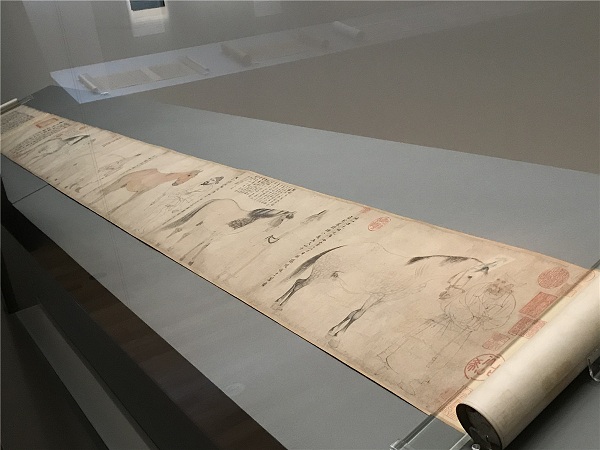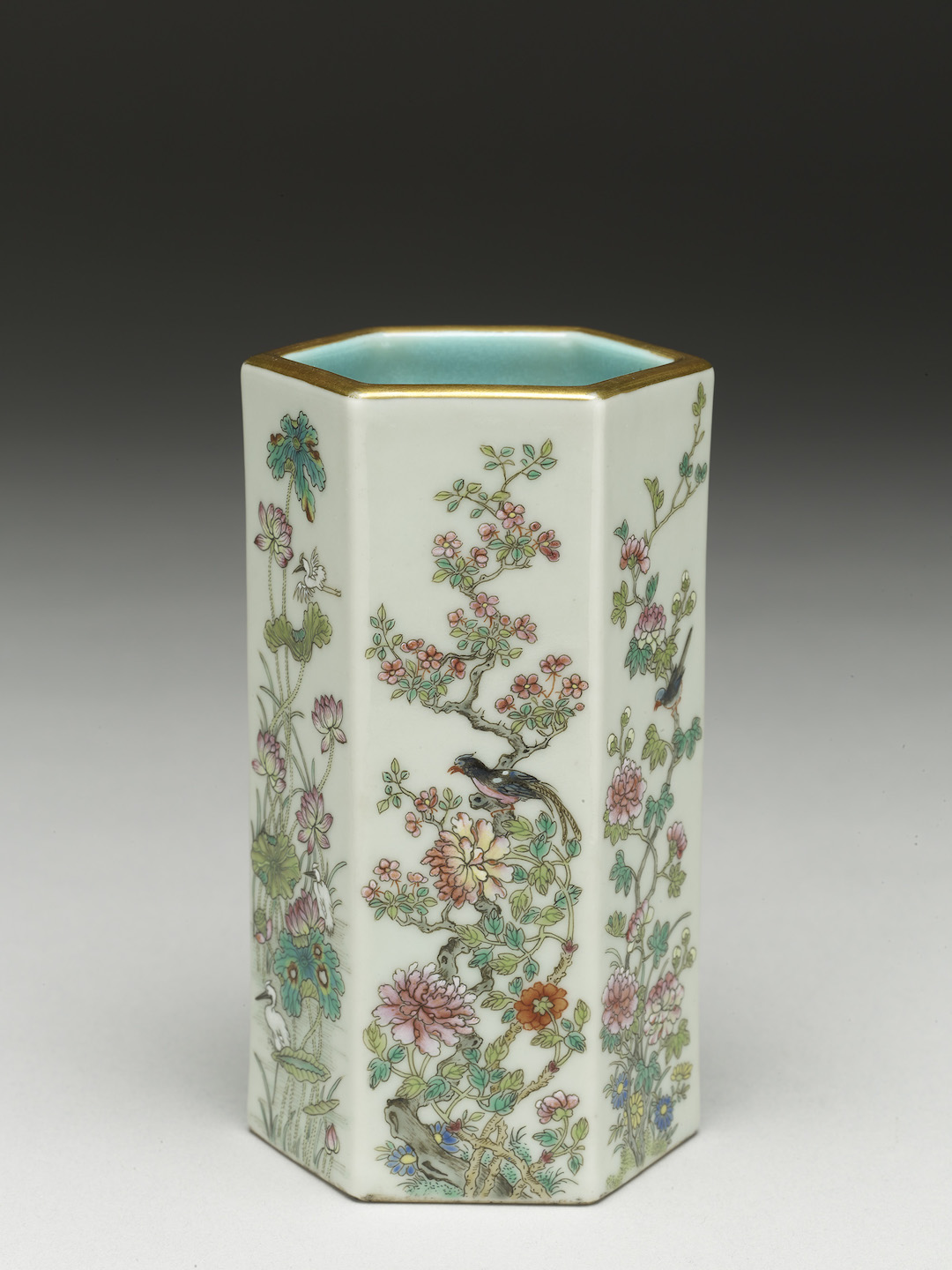
Three pieces of porcelain relics in the National Palace Museum in Taipei were damaged, and the storm continued to attract attention. On November 1, the National Palace Museum in Taipei released a comprehensive record of the status and maintenance of cultural relics over the years. According to the data from the past years, the number of ceramic wares in the National Palace Museum in Taipei was assessed and sent for repair. There are a total of 359 pieces.
It is reported that in early November, the National Palace Museum in Taipei will fully disclose the status, inventory, sampling and repair records of the cultural relics that have completed the construction of digital data in the database of "Retrieving the Archives of the Palace Museum", so as to provide external inspection and reading. According to the National Palace Museum in Taipei, the subsequent repair methods include filling, coloring, gluing, sealing, etc., which will be implemented after professional evaluation, depending on the damage. At the same time, when the collection management unit inspects the cultural relics, if it finds that the cultural relic is damaged or broken or needs to be strengthened, it will record and evaluate whether to send it for repair, so as to avoid the continuous expansion of the damage or carry out preventive protection.
Recently, the National Palace Museum in Taipei damaged three pieces of porcelain in more than a year, sparking criticism from the outside world. According to Ye Guoxin, an art appraiser in Taiwan and a member of the cultural relics and art appraisal committee of the Taiwan Museum of History, who told the local media that among the three cultural relics, the small yellow and green Ssangyong small bowl of the Ming Dynasty Hongzhi style is less handed down. According to United News, on the evening of November 1, the National Palace Museum in Taipei fully disclosed the status and maintenance records of cultural relics over the years. According to historical data, a total of 359 pieces of ceramics in the National Palace Museum in Taipei have been assessed for damage and rupture and sent for repair.
According to the news from TVBS News Network and United News Network in Taiwan, Chen Yixin, a "legislator" of the Kuomintang, broke the news a few days ago that in February last year, when the National Palace Museum in Taipei conducted a digital collection of cultural relics, the cultural relic "Ming Hongzhi Model Jiaoyellow Green Color Shuanglong Small Bowl" was accidentally broken. After the incident, the relevant personnel immediately reported to Wu Micha, director of the National Palace Museum in Taipei, but Wu ordered the relic not to be handed in or recorded.
According to the previous investigation report of the National Palace Museum in Taipei, the "Ming Hongzhi Jiao Huang Green Shuanglong Small Bowl" and the "Qing Kangxi Dark Dragon Baili Small Yellow Porcelain Bowl" were found to be broken after they were opened, and the cause of the damage of the "Qing Qianlong Blue and White Flower Plate" was determined. It is caused by "human negligence".
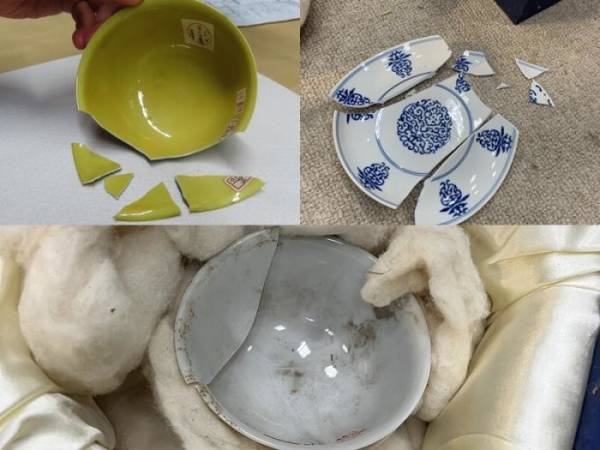
The National Palace Museum in Taipei stated that on February 3, 2021 and April 7, 2022, after unpacking the cultural relics, they found "Ming Dynasty Hongzhi Model Small Yellow and Green Shuanglong Small Bowl" (upper left), "Qing Dynasty Kangxi Model Dark Dragon Baili Small Yellow Porcelain Bowl" "(bottom) was damaged; when the cultural relics were sorted out on May 19, 2022, due to the negligence of the personnel during the operation, the "Qianlong blue-and-white flower plate of the Qing Dynasty" (top right) was dropped and damaged.
Regarding the value of the damaged cultural relics, according to different sources of various media in Taiwan, there may be an estimated value of NT$2.5 billion. In this regard, Wu Micha, director of the National Palace Museum in Taipei, relayed information from his colleagues, saying that with reference to the situation of market circulation, the total value of cultural relics is "absolutely far, very far below this number", but the damage to the three cultural relics, he wants to "Take responsibility."
Ye Guoxin, an art appraiser in Taiwan and a member of the cultural relics and art appraisal committee of the Taiwan Museum of History, told local media that the market price of the small bowls with yellow and green colors in the Ming Dynasty was about NT$20 million to 30 million, because the small bowls with yellow and green colors were produced. The quantity is small, and the handed down products are few. In the Qing Dynasty, the Qianlong blue-and-white flower plate was relatively inexpensive because of its large production volume and handed down. In addition, the surface decoration was relatively simple and patterned, so the value was relatively low. The market price was between NT$1 million and NT$2 million. In addition, the market price of a small yellow porcelain bowl with a dark dragon and white li of the Qing Dynasty was between NT$10 million and NT$15 million. As for the general repaired price, if the repairing teacher is highly skilled, even if the repair is complete, the price will be about half, depending on the degree of repair. Therefore, the total value of the three damaged cultural relics is about NT$31 million to NT$47 million.

Taipei Palace Museum North Campus
According to reports, Taiwan's "Legislative Yuan" Education and Culture Committee arranged to visit the Taipei Palace Museum on the 7th. Zheng Zhengqian, a member of the Kuomintang Party, said in an interview on the 1st that the purpose of the inspection was to understand the cause of the damage and the handling process of the Palace Museum. After the cultural relics were opened, they were found to be broken. It is really suspicious that the third cultural relic was even broken due to human manipulation, and it also makes people question whether the Taipei National Palace Museum has good standard operating procedures.
In this regard, the Kuomintang "legislator" Lai Shibao once posted a crusade against the Taiwan authorities and Wu Micha on Facebook. Lai Shibao questioned that the cultural relics have long been damaged, but Wu Micha blocked the news black box operation and did not face it until he was exposed. He believes that Wu Micha's job as the director of the National Palace Museum in Taipei is just a passing mentality of receiving a salary, and such a mistake will occur. It is the result of almost no professional training for employees and no internal control. Such continuity has not occurred in any previous director. of cultural relics.
According to news from the United News, the National Palace Museum in Taipei released the status and maintenance records of the cultural relics over the years on the evening of November 1. According to the historical data, the ceramic wares were damaged and ruptured due to different degrees of severity. There are 359 pieces. Among them, the "Chenghua style white ground colored flower porcelain cup" and "jade potted planting landscape" sent for repair in 2014 and 2015 were all found to be broken when they were picked up. At the same time, there are also records of cultural relics repaired due to damage, such as "the Qing Dynasty ivory carving cloud and bat pattern all bearing plate", "the Qing Dynasty Kangxi model imitation Song Dingyao three-series small porcelain pot".
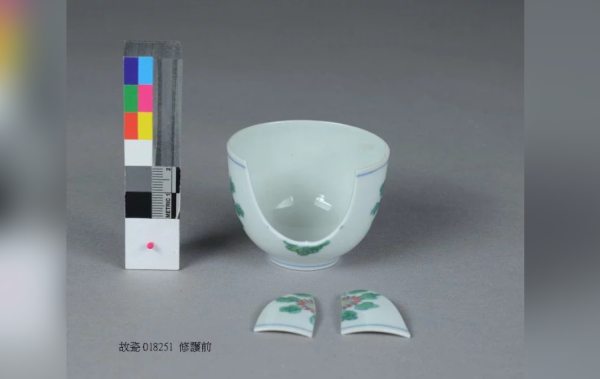
The National Palace Museum in Taipei released the photos before restoration of the "Chenghua Type White Floor Color Flower Porcelain Cup", which has now been restored. The picture is provided by the United News Network Taipei Palace Museum
According to the National Palace Museum in Taipei, the subsequent repair methods include filling, coloring, gluing, sealing, etc., which will be implemented after professional evaluation, depending on the damage. At the same time, when the collection management unit inspects the cultural relics, if it finds that the cultural relic is damaged or broken or needs to be strengthened, it will record and evaluate whether to send it for repair, so as to avoid the continuous expansion of the damage or carry out preventive protection. According to the report, the National Palace Museum in Taipei is scheduled to fully disclose the status, inventory, sampling, and repair records of the cultural relics that have completed the construction of digital data in the "Forbidden City Collection Data Retrieval" database in early November, so as to provide external inspection and viewing.
In recent days, various parties have criticized the current director Wu Micha for the damage of three pieces of porcelain in the National Palace Museum in Taipei, saying that "the National Treasure of the Palace Museum was broken for the first time in the history of the Palace Museum" during his tenure. Taiwanese media said that the Kuomintang "Legislative Yuan" caucus asked Wu Micha to step down, and asked the National Palace Museum in Taipei to publish surveillance footage, take a comprehensive inventory of the cultural relics, and ask experts to identify relevant cultural relics. The United Daily News published an article saying that the "internal and external problems of the National Palace Museum in Taipei need to be resolved professionally."
Weng Jiayin, a researcher at Taiwan's "Institute of Taiwan History of the Chinese Academy of Sciences", said that it is "no secret" that the cultural relics of the National Palace Museum in Taipei are missing or damaged. He said that Jiang Fuzhen (the director of the National Palace Museum in Taipei from 1965 to 1983) broke the bowl during his tenure, and that there were items on the list that were missing during his tenure as director, and some were broken after entering the warehouse. Regarding Weng Jiayin's remarks, some netizens said that he was obviously justifying the DPP.
On November 1, the Kuomintang candidate for Chiayi County Mayor Wang Yumin criticized the DPP for not admitting mistakes and apologizing in the political talk show "Shaokang Situation Room" and for "doing something wrong and loving debate". Wang Yumin asked the DPP, "Have you sincerely apologized after being exposed? Do you feel that you have seriously neglected your duty? They are all tough."
In addition to the damage to the cultural relics, the "Lanqianshan Museum" of the National Palace Museum in Taipei will no longer renew the contract for the storage of cultural relics, which has also caused controversy recently. The official website of the National Palace Museum in Taipei responded, "The warehouse space is limited, and the preservation of its own cultural relics has become very narrow. It is not suitable to provide private storage for free for many years, consuming the resources of the Palace Museum for storage and maintenance, and crowding out various resources of its own cultural relics." It also stated that Taipei After the contracts for depositing cultural relics have expired, the Palace Museum has notified several depositors to retrieve the cultural relics. The "Lanqianshan Museum" is not a special case.
It is understood that the so-called "deposit" means that private collectors authorize the Taipei Palace Museum to store and display cultural relics free of charge, but the name of the depositor must be marked. This is a kind of honor for collectors. It not only encourages the public to share collections, but also provides the most complete and professional preservation of cultural relics, and provides the audience with a variety of visiting contents.

Tang Chu, Suiliang, Yellow Silk Scroll, Lanting, Lanqianshan Museum, National Palace Museum, Taipei
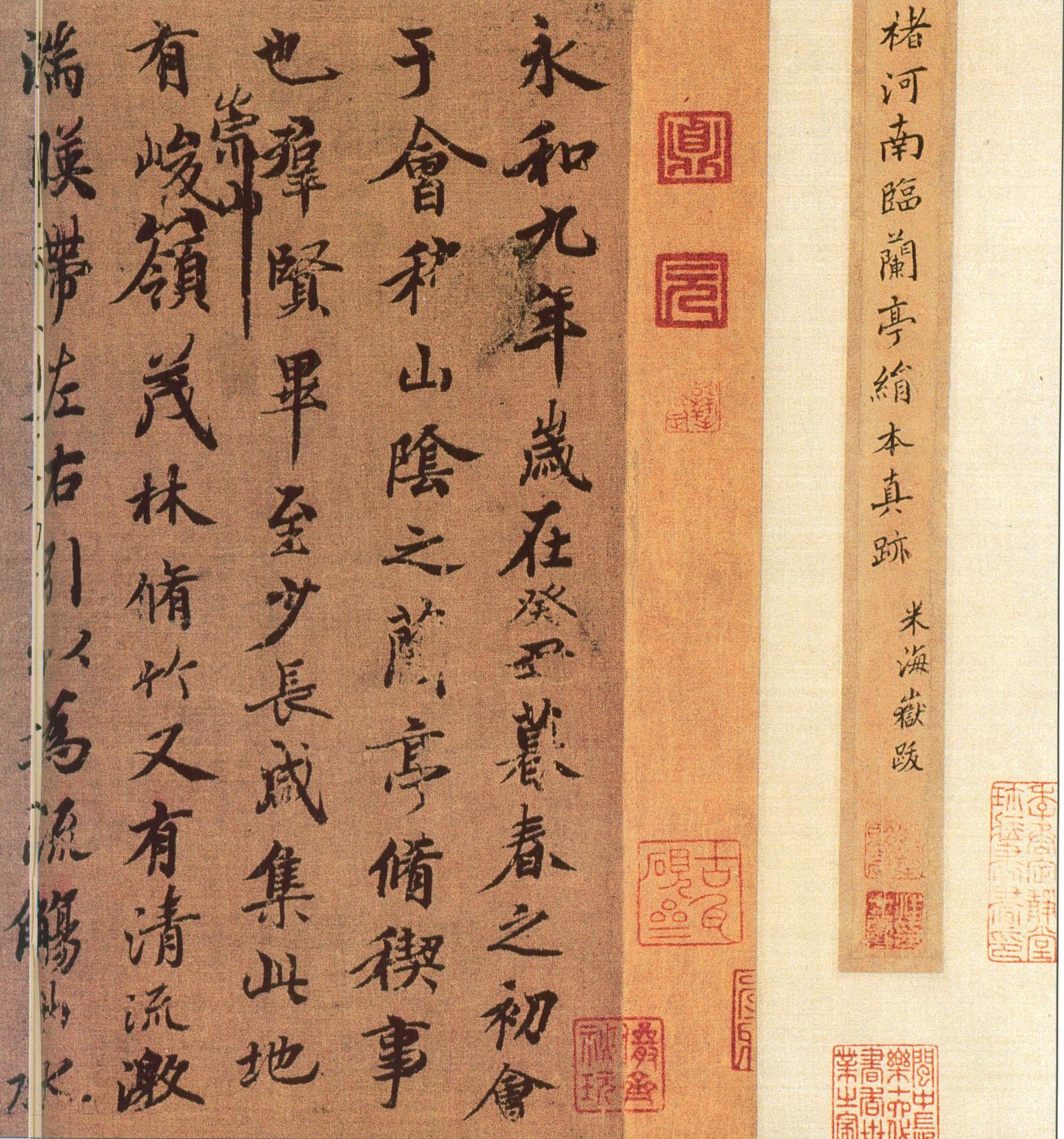
Tang Chu Suiliang Yellow Silk Orchid Pavilion (Part) Lanqianshan Pavilion Deposited at the National Palace Museum, Taipei
The Paper has learned that the two cultural relics "Tang Chu Suiliang Yellow Silk Ben Lan Ting" and "Tang Huai Su Xiaocao Thousand Characters" among the cultural relics stored in the "Lanqianshan Pavilion", which is no longer contracted by the National Palace Museum in Taipei, are being launched by the National Palace Museum in Taipei. Exhibited in the exhibition "Writing Prosperity - Wang Shizhen, a late Ming cultural man and his career". Due to the storage of the "Lanqianshan Museum", these two cultural relics were also exhibited in Tokyo, Japan, together with Yan Zhenqing's "Manuscript of Sacrifice to Nephew", which is of great importance, but there are cultural relics from the National Palace Museum in Taipei and the "Lanqianshan Museum". Not renewing the contract also means that the important cultural relics in it will leave the National Palace Museum in Taipei, and the public will not have the chance to see each other again.
Duan Xinyi pointed out that Mr. Lin Boshou, the owner of "Lanqianshan Museum", was elected in 1969 as a standing member of the management committee of the Sun Yat-sen Museum, the predecessor of the National Palace Museum in Taipei, because of his knowledge and love for cultural relics. His private collection includes 219 paintings and calligraphy, The ancient inkstone 109 is stored in the Zhongshan Museum. Among these cultural relics, "Tang Chu Suiliang Yellow Silk Orchid Pavilion" and "Tang Huai Su Xiaocao Thousand Characters" are particularly treasures. The market value of these two pieces alone far exceeds the three recent damaged porcelain cultural relics; For example, "Huayan Sketchbook" is also a very precious album. It is an epoch-making push to promote the "realism" of Chinese painting to "one picture and one environment". Duan Xinyi asked: "These are all supporting the face of the Forbidden City. Why don't you stay if you have been to Japan to borrow Sutra Exhibition?"

Hua Yan's sketchbook, the first image of a camel, 20 x 25.4 cm, is stored in the National Palace Museum, Taipei

Hua Yan's Sketchbook, Volume 2, the fourth bee-eater, 20.2 x 25.5 cm, Lanqianshan Museum Stored in the National Palace Museum, Taipei

Hua Yan's Sketchbook, Volume 2, Seventh Beehive, 20.2 x 25.4 cm, Lanqianshan Museum, National Palace Museum, Taipei
According to Taiwanese media reports, senior staff of the National Palace Museum in Taipei signed a petition requesting the dean to renew the contract for the "Lanqianshan Pavilion" to keep the cultural relics in the Palace Museum. The statement pointed out that "whether or not to renew the contract will be discussed by the Palace Museum and the depositor." It hoped that the outside world "respects the wishes and privacy of the owners of the deposited cultural relics." In this regard, an insider of the Palace Museum in Taipei also said that in fact not renewing the contract is a matter of fact. The National Palace Museum in Taipei unilaterally proposed.
Duan Xinyi pointed out that from the damage of cultural relics and the non-renewal of the "Lanqianshan Museum", I have to question the biggest problem in the management of the National Palace Museum in Taipei today is that it does not respect professionalism, including the original artifacts, painting and calligraphy, and documents. In addition, the director of the painting and calligraphy and literature department is also in charge of the artifact department. Originally, it was a department in different fields. Coupled with the reduction of manpower, it was frequently moved for the cultural relics to be moved to the South. requirements.
Liu Fangru, the former director of the Calligraphy and Painting Documentation Department of the National Palace Museum in Taipei, posted on a social platform, "In the end, it is too embarrassing to let the good intentions of Mr. Lin Jicheng (referring to Lin Boshou), the owner of the Lanqianshan Museum, come to nothing!" He also said, "In all fairness, if Lan Qian's cultural relics can continue to remain in the museum, not only will the preservation environment be better, but it can definitely play a more diverse art education function."
(This article is based on the relevant reports of United News, Observer.com, Global Times, The Paper, etc.)
